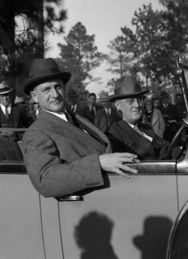
The United Nations has been portrayed as the world’s most important humanitarian organization. The propaganda supporting this view has been continuous for so long that few doubt the depiction. When disasters such as the devastating Asian tsunami occur, the UN and its pundits are quick to position the world body in the limelight with pronouncements depicting the organization as the leading supplier and coordinator of relief and aid.
Such a picture of the UN as merely a helpful relief and humanitarian agency is dangerously deceptive and inaccurate. It is true that the world body does participate in relief efforts when disasters occur, but this is only the public face of the organization. A clear-eyed survey of the makeup of the UN, though, finds that the world body is much more than a relief organization. It has, for instance, a clearly delineated executive branch in the office of the secretary-general. It has a similarly delineated legislative branch in the General Assembly and Security Council. And it has subsidiaries and affiliates, like the World Court, the nascent International Criminal Court, and certain tribunals, that function as a judiciary branch.
Those familiar with the composition of governing bodies will recognize in this structure the basic framework of government. And this is precisely what the United Nations is and always has been. In fact, from the very moment of its birth during and immediately following the great upheaval of World War II, the true purpose of the United Nations has been obscured. Born in secrecy while the world convulsed in the violence of war, the founders of the world body, primarily found in the subversive and internationalist ranks of the Council on Foreign Relations, labored to lay the groundwork for world government. The United Nations was designed from the beginning to be the instrument through which they would achieve this dangerous goal.
Prewar Planning
On December 22, 1941, just two weeks after the Japanese attack on Pearl Harbor, British and U.S. officials met in Washington, D.C., to discuss matters pertaining to war. The discussions, dubbed the Arcadia Conference, lasted until January 14, 1942. During the talks, British Prime Minister Winston Churchill pushed for aggressive military action and agreed with U.S. officials and President Franklin Delano Roosevelt on a “beat Germany first” strategy. Roosevelt, for his part, began immediately to lay the groundwork for the post-war world by presenting a draft for a “Declaration of the United Nations.”
This early declaration was perceived at the time as providing the Allied powers with a formal, unified front from which to face the dangers posed by Nazi Germany, Imperial Japan, and the other Axis nations. Nevertheless, it contained in broad outline the foundation for what would become the world body. The fact that the draft declaration was available just a few short weeks after the bombing of Pearl Harbor suggests that the document had, in fact, been in the works for some time prior to the entry of the United States into the war.
In fact, work to lay the foundation for a new international order had begun some years earlier and was carried out by key Roosevelt adviser Sumner Welles. A devotee of former President Wilson, Welles was a dedicated internationalist and member at a young age of the Council on Foreign Relations (CFR). The CFR was an outgrowth of efforts to form a new international order after the failure by the Wilson administration to get us into the League of Nations. Since that time, the CFR has pushed the world government line.
In 1937 Welles, then undersecretary of state, proposed what came to be called his “American System” through which he thought it would be possible to create “a new world order.” According to the book Sumner Welles, Postwar Planning, and the Quest for a New World Order, 1937-1943 by Christopher D. O’Sullivan, professor of history at the University of San Francisco, Welles proposed that Roosevelt “call for sweeping arms reductions, the lowering of international trade barriers and the unity of the neutral powers in quarantining aggressor nations.”
When war engulfed Europe in 1939, Welles and other Roosevelt administration internationalists sensed an opportunity to use the fighting to advance plans for a new world order. The U.S., though, was not yet in the war, and it would seem out of place, the administration thought, for the U.S. government to begin official efforts at postwar planning. Such planning would need to be initiated outside of official government offices. Naturally, CFR member Sumner Welles looked to the council for help. According to O’Sullivan, “A few weeks after the outbreak of war, he asked Hamilton Fish Armstrong, the director of the Council on Foreign Relations, to prepare for him a number of detailed studies on postwar planning.”
Shortly afterward but still in 1939, Welles assembled a committee within the State Department to study postwar planning. The Welles Advisory Committee on Problems of Foreign Relations was singularly concerned with world order. According to the State Department, the body would “survey the basic principles which should underlie a desirable world order to be evolved after the termination of present hostilities.” The committee would also “determine policies which should be pursued by the United States in furtherance of the establishment of such a world order.”
Roosevelt and his internationalist confederates were determined to use the war to submerge the U.S. and other independent nations in a system of world government. On July 22, 1941, Welles made the administration’s aims clear in a speech broadcast by radio throughout the nation and occupied Europe. The U.S., he said, would seek a replacement for the League of Nations. “I cannot believe that peoples of goodwill will not once more strive to realize the great ideal of an association of nations through which the freedom, happiness, and the security of all peoples may be achieved. That is the objective before us all today — to try and find the means of bringing that to pass.” In short, Welles had announced, said historian O’Sullivan, “that American war aims should seek to forever change the global status quo. He desired a postwar settlement based not on great-power politics and the balance of power but on a universal vision of a new world order.”
Building the New World Order
In August 1941, President Roosevelt secretly met with British Prime Minister Winston Churchill. Roosevelt was to negotiate with Churchill an agreement that would firmly align the United States with Britain both for wartime purposes and for the postwar world. The result of the meeting was published on August 14, 1941 as the Atlantic Charter. Welles desperately wanted the charter to include explicit mention of a system of world order, and the original draft of the charter did call for the creation of “an effective international organization.” Both Welles and Churchill pushed for the inclusion of such language, but Roosevelt, fearing a domestic backlash if the wording was left in, stood fast on its removal, inserting instead an oblique reference to the future “establishment of a wider and permanent system of general security.”
The Atlantic Charter was the kernel around which the United Nations was formed. That its aim was the submergence of sovereign states, including the United States, under an all-powerful world government was ably explained as early as February 13, 1943 by New York Congressman Joseph Clark Baldwin. Baldwin, a supporter of the charter, explained how under its terms national sovereignty would be diminished. “Local police forces … obviously should be reduced as state and national police protection is increased,” Baldwin said in a speech to the Foreign Policy Association of Pennsylvania. “So our national armed forces can and should be reduced as soon as a permanent international police force is set up.”
To Arcadia and Beyond
With this groundwork in place well before the attack at Pearl Harbor, the Roosevelt administration was well positioned to move forward with postwar planning for what would become the United Nations. Beginning with the aforementioned Arcadia Conference in Washington, D.C., on December 22, 1941, plans to build the UN began accelerating. At Arcadia, 26 nations agreed to the terms of the Atlantic Charter, the group being christened for the first time by Roosevelt as the United Nations.
Arcadia, though, was just the formal beginning of the process that resulted in the UN. Even before Pearl Harbor, Sumner Welles had been asking Roosevelt to authorize yet another secret committee to formulate plans for the creation of and U.S. participation in an international governing organization. Roosevelt apparently agreed, and Secretary of State Cordell Hull assumed the role of chairman of the new committee. When Hull took his annual leave, though, at the beginning of 1942, Sumner Welles, the undersecretary of state, found that the other appointments to the committee had not yet been made. Sensing an opportunity to pack the committee with like-minded CFR internationalists, Welles set about sending invitations. When he was through, the new Advisory Committee on Post-War Foreign Policy (later the Informal Agenda Group) would include a who’s who of committed one-world internationalists from the CFR. Welles appointed himself head of the group’s subcommittee in charge of defining the nature of a postwar international organization. To that end, he proposed, in March 1942, the creation of a “United Nations authoritative body.”
Under the general oversight of Secretary of State Hull, Sumner’s committees completed their work during 1942 and 1943. According to historian Christopher O’Sullivan, Sumner’s work “included an examination of other international organizations (with special attention paid to the League of Nations), the drafting of a constitution for the new world body, a detailed examination of international trusteeship and, later, formulating suggestions on how to endow a new world organization with a military capability. During its existence the subcommittee on international organization would succeed in creating the blueprint for a new world body that would evolve into the United Nations.”
The New World Order
Strictly speaking, the Welles-Roosevelt-CFR plan for a new world order came to fruition with the founding conference of the UN in San Francisco in 1945. Significantly, the secretary-general of the conference was none other than Soviet spy Alger Hiss. But Hiss was far from the only Communist or Communist sympathizer to be heavily involved in the creation of the UN. Moreover, Communist interest in the world body pointed toward its true purpose. After all, Communists were and are dedicated to creating a one-world Communist superstate. Their heavy involvement in the world body’s founding is a powerful indictment of that organization’s true purpose as a nascent world government.
The United Nations has continued down to the present to be used by one-worlders to build world government. Though leaders have been comparatively circumspect about their goals in recent decades, suggestive and sometimes explicit statements are still made.
For example, Kofi Annan views the UN as an instrument of global government. On January 14, 2000, Annan lauded the work of the UN in creating “a framework of international law,” before going on to say: “Local communities have their fire departments and town councils. Nations have their courts and legislatures. In today’s interdependent world, the peoples of the world must have the rules and institutions they need to manage their lives.” At a press conference in 1999, he was even more explicit, saying, “every community needs rules. The international community needs them as much as a local community or a district…. [T]he challenge on the global level — what I will call global governance — is something that is going to confront us all very, very starkly.”
Should the trend toward world government initiated by Sumner Welles and other internationalists during World War II continue unabated, the world will indeed have peace, the kind of peace that comes under the iron grip of a world-spanning totalitarian bureaucracy.
Photo: AP Images



